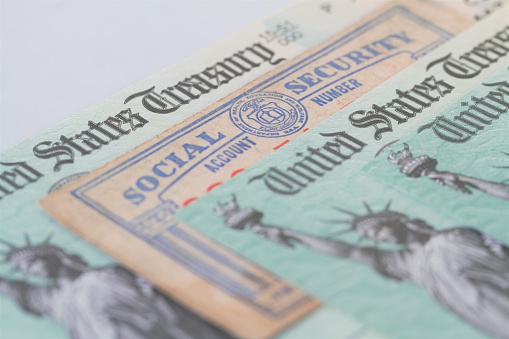The Insecurity in Social Security
One of the few things where there is widespread agreement is about the fact that Social Security and Medicare are going broke unless something is done to stem the financial drain as the retirement rolls swell. Choices are raising taxes or cutting benefits. Neither alternative is palatable politically, so the problem is put off for another day.
The reasons for the financial problems are legion: the huge drop in the birth rate; too generous increases in benefits; the elderly living much longer; etc. A big problem is that the return on the Trust Fund assets is pathetically low due to historically low-interest rates.
Let’s take a look at that last point.
Programs in the social safety net are not “insurance”. They are essentially Ponzi schemes. Because that name is so incendiary and so associated with criminal activity, Bernie Madoff, etc., I need to explain.
An insurance program spreads risks among a group of insureds. It is financially on a “pay now-receive benefits later basis”. It is the role of actuaries to determine what level of premium is needed to support the benefits for all members of the group. The insuring company maintains reserves so that cash flows are adequate over the time the arrangement is in effect.
Social Security and Medicare are not set up on that basis. There are government actuaries involved, of course, but the group is open-ended, the terms keep changing, and the time horizon is infinite (although 75 years is commonly assumed for calculation purposes). That does not mean this sort of arrangement is essentially unsound. It is just different than under a true insurance program.
A Ponzi scheme is one where benefits are paid out to early joiners, enrollment is open-ended, and the benefits paid to the early participants are paid for by the contributions of later joiners. There is no buildup of a reserve.
The reason to call Social Security and Medicare Ponzi schemes is that there is no buildup of reserves as there is under an insurance plan. We are told that there are reserves in the so-called Trust Funds, but the contributions we make are not placed in those Trust Funds. The Government spends the money for its other expenses. What goes into the Trust Funds are promises to pay cash to beneficiaries in the future. It does not take a financial genius to understand that there is a fundamental difference between cash in hand and a promise to pay. Of course, we believe that the Government is trustworthy, and in fact, there is every intention to pay benefits as they come due.
However, and this is the vital part, in order to pay, you have to have the cash to do so. Since our cash is already spent, the money has to be raised elsewhere, presumably via higher taxes. In a criminal Ponzi scheme, the operators must constantly seek new participants whose contributions can be used to satisfy the existing participants. At some point, this becomes impossible; the whole enterprise collapses; investors lose their money, and people go to jail.
The Government escapes by having the option to just print the money, inevitably leading to money losing its value. However, it is the same sort of deception. The Trust Funds are rapidly reaching the situation where the money going out exceeds money coming in. In a few years, there will be a crisis, something very drastic (and painful) will have to be done. The only question is who will be hurt: beneficiaries, taxpayers, or both. Either beneficiaries will get less or taxpayers will pay more.
This did not need to happen. If our contributions had been invested in real assets instead of promises, there would be adequate reserves and no looming crisis. Why wasn’t this done? The short answer is that FDR did not trust Wall Street to manage such huge funds. Things like mutual funds and ETF’s did not take off until after WWII.
In his State of the Union message 20 years ago, Bill Clinton proposed investing part of the Trust Funds in the Stock Market. He was laughed at and dropped the idea. Why?
There are three legitimate arguments against the idea.
- The risk is too great. Stocks fluctuate wildly. It would be morally wrong to gamble with our retirement security.
- Politicians would screw it up. Such a huge concentration of financial assets would be an irresistible magnet for politicians who might find “better uses” for the money (i.e., projects that would enhance their power and re-election chances).
- It is impractical because it is too late. We can’t take the current Trust Funds and invest the money in stocks because there is no money, just promises (which is what the beautifully engraved government bonds actually are – just I.O.U.’s). Those billions upon billions of dollars of bonds would have to be sold in order to turn them into investible cash. Who would buy them?
Let’s go over each of those arguments.
In the 20 years since Clinton’s proposal, we have experienced the wild volatility arising from the 9/11 attacks, the bursting of the Dot.com Bubble, the financial crisis and Great Recession, and the Covid crisis. Despite that, money invested at the time of Clinton’s proposal would have earned an average annual return of over 7%, and more if a program of dollar-cost averaging had been adopted.
Furthermore, unless you believe the U.S. is going to collapse totally someday, who is better able to weather the short-term fluctuations of the markets than a government fund? Many countries, from Singapore to Saudi Arabia have benefited from introducing what is known as “Sovereign Wealth Funds” (SWF’s) to partially fund their government programs. Stock Markets exist to provide businesses with capital to grow. Our government keeps throwing money at programs that are supposed to stimulate growth but rarely do. There is no reason to single out one approach as morally wrong simply because you don’t like Capitalism.
There is always the concern that eventually the Government “would own everything”. This is an error born of ignorance of the small size of even the large amounts needed to fund our safety net programs in relation to the immense size of the financial markets. The Trust Fund money could be invested in special ETFs consisting of non-voting stock in say the 5000 largest companies. That would broadly spread the risk and prevent politicians from trying to dictate how management should run their companies. Of course, politicians could still try to inject their political preferences into the functioning of the economy, but they could not use the shares in the Trust Funds as a political tool.
If we were starting from scratch, implementing such a SWF for the purpose of funding the social safety net programs would be easy. However, we have already reached the point where net cash inflows (taxes collected minus benefits paid) are shrinking or have turned negative. We could, of course, liquidate the government bonds (the promises) held in the Trust Funds. But this would not be simple. Who would buy them? The Government is already choking on the vast quantity of debt it has to sell to fund its current budget shortfalls and various stimulus packages. Most of the present deficit is funded by selling debt to the Fed. Why not some more? It has the benefit of getting the truth out that the vast quantity of money owed by the United States is out of control. The fact that we owe the money to ourselves (i.e., the Trust Funds) adds elements of a 3-Card Monte game to the Ponzi scheme, where we disguise what we are doing as we shuffle financial instruments from one hand to another. Better we know the truth.
What other arguments can be raised against a SWF? Some will say it could destabilize markets because we would see huge sums of money flowing in and out. This is disingenuous. Markets today handle enormous shifts of investments in and out of multi-billion-dollar funds with hardly a ripple.
Others resent the possibility that organizations such as Goldman Sachs would stand to make “unconscionable amounts” from a program designed to help the poor and elderly. That is a political question. Advisory and transaction fees can be constrained by law in the case of SWF investments. Wall Street should be compensated for services provided. Only political will is needed to keep them from reaping windfall profits.
As a Conservative, I often find myself opposed to Progressive programs that are worthy but are misguided because we simply can’t afford them. If the Government was allowed to invest some of the vast amounts of money they throw at well-intentioned programs, we might reduce some of the tension between those who have “demands” and those who resent paying. A SWF invests in the belief in one’s own country and it helps to make dreams come true. Perhaps it is time to put aside political posturing and try to find a way to capitalize on our strength as a nation instead of finding reasons to just continue with programs that inevitably disappoint.
Ken Veit is a retired actuary.




